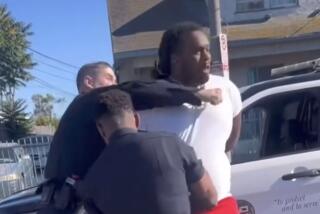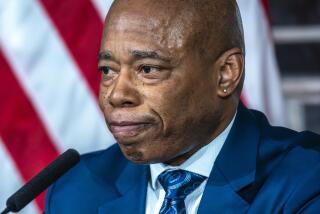Philadelphia Police Face U.S. Probe
- Share via
WASHINGTON — The Justice Department began a preliminary investigation Thursday into the actions of a dozen Philadelphia police officers who were captured on videotape kicking and beating a black man suspected of carjacking.
The footage, shot by a news helicopter, shows the officers pulling Thomas Jones, 30, from the patrol car that he also allegedly stole. They then kicked and struck him while he was on the ground before taking him away in handcuffs and a headlock.
The images evoked memories of the infamous 1991 beating of motorist Rodney G. King, who repeatedly was struck by baton blows and kicked by Los Angeles officers after a high-speed police chase.
But civic leaders and police officials in Philadelphia said Thursday there is no comparison.
“It looks awful,” Philadelphia Police Commissioner John F. Timoney said of the images on the tape. But “this is not Rodney King.”
The critical question, Timoney said, was: “At what point did the resistance cease and was unnecessary force used?”
On that point, Philadelphia Mayor John Street, who is black, quickly promised a “proper and fair investigation.”
The Rev. Robert Shine, vice president of the Black Clergy of Philadelphia and Vicinity, said that “the only parallel [with the King beating] is the fact it was police officers who deemed it necessary to use excessive force. The Rodney King incident was racial.” Unlike with King, some of the officers who joined in the Jones incident were black.
Shine and other leaders of the clergy called for calm as Philadelphia prepares to host the Republican National Convention in less than three weeks.
Suspect Is in Hospital in Serious Condition
Jones was listed in serious condition Thursday at Temple University Hospital with bullet wounds to his stomach and arms, suffered during a gunfight with officers. He was charged with attempted murder of a police officer, assault, resisting arrest and other offenses. He was also charged with three purse snatchings that took place in the 24 hours leading up to the beating.
Police said they found a crack pipe in the stolen car and were awaiting the results of a toxicology test on Jones. Jones has been in and out of jail on such charges as robbery, auto theft and aggravated assault, police said.
But Jones’ relatives disputed the police account, saying he did not fire a gun and took the police car only because officers were beating him.
“He was afraid for his life. I would have done the same thing,” said nephew Stanley Jones, 19.
The federal civil rights investigation was one of three inquiries into the incident. Police also have launched two internal-affairs investigations, and WPVI-TV, which shot the tape, has turned over a copy to the district attorney’s office.
The incident began Wednesday when police spotted an erratic driver. A radio check reportedly determined that the car had been stolen. Two officers stopped the car, and a foot chase and what police said was an exchange of gunfire followed.
Police said Jones managed to jump into the empty police car and drive about a mile to an intersection, where he was stopped by other officers.
Police Capt. James Brady said that Jones shot one officer, wounding him slightly, then tried to run over a second and bit a third on the hand during the arrest.
Brady said police had recovered 43 cartridge cases at the intersection where the car was stopped, “the majority” from police. But they were unable to find the gun police said Jones used.
“We are still looking into that,” Brady said. “We are not, at this early stage of the investigation, going to rule anything out.”
“The issue for us is, where is the paraffin test that shows the gun in [Jones’] hand,” Shine said. “Why was he knocked to the ground, stomped, kicked and punched? Why was the window of the police car shot out? Why did a police officer have to leap over the car to join the fray?”
Brutality Issue Is Raised
The Rev. Vernal Simms, president of the Black Clergy of Philadelphia and Vicinity, said race clearly was not an issue.
“We saw the tape; we saw that there were as many black officers kicking and punching and jumping as white,” Simms said “We are not questioning that. We are concerned about the whole brutality.”
“‘We’re going to do a thorough investigation,” Timoney said, “and if officers are found to have overstepped their boundaries, they will be dealt with.”
The police chief said that one officer has been assigned to desk duty for firing his weapon during the chase, a measure that is standard procedure during an investigation. Several others shown in the video will also be reassigned, he said.
Civic leaders expressed confidence Thursday in Timoney, a former high-ranking New York City police commander.
(In the 1960s and ‘70s, Philadelphia was accused of having one of the most brutal police forces in the nation under Police Commissioner and later Mayor Frank Rizzo. More recently, the department reached a legal settlement calling for internal reforms, including the creation of a corruption task force.)
The official police response in Philadelphia on Thursday was markedly different from the LAPD’s actions in the wake of the King beating.
At that time, some Los Angeles police officials refused to discuss the matter until it was investigated by the department’s Internal Affairs unit. Others quickly rallied around the four officers who ultimately were charged with the beating.
Those who supported the officers insisted that the beating was within LAPD guidelines and that King had fought with the officers in the moments before his arrest--scenes not caught on that infamous videotape.
Then-Police Chief Daryl F. Gates called the King beating an “aberration” and said what happened to King at the end of the police chase in Lakeview Terrace was not indicative of the way his officers conducted themselves.
Sources said, however, that Gates was privately upset that the supervising sergeant let things go too far during King’s arrest.
Many Los Angeles police officials also publicly mocked King, a convicted felon at the time of his arrest, and indicated that he deserved the beating after threatening the lives of officers who chased him at high speeds.
They also said he was a threat because he must have been high on drugs, specifically PCP, and that a large amount of force was needed to subdue him. It was later shown, however, that King was not on drugs during the beating but was legally drunk.
A civil jury awarded King $3.8 million in connection with the beating.
*
Goldman reported from New York and Serrano from Washington. Times staff writer Eric Lichtblau in Washington and Associated Press contributed to this story.
A video clip of the kicking and beating of the suspected carjacker in Philadelphia can be viewed on The Times’ Web site:
http://pyxis.nohib.com/philly
More to Read
Sign up for Essential California
The most important California stories and recommendations in your inbox every morning.
You may occasionally receive promotional content from the Los Angeles Times.











